| Reviews & Columns |
|
Reviews DVD TV on DVD Blu-ray 4K UHD International DVDs In Theaters Reviews by Studio Video Games Features Collector Series DVDs Easter Egg Database Interviews DVD Talk Radio Feature Articles Columns Anime Talk DVD Savant Horror DVDs The M.O.D. Squad Art House HD Talk Silent DVD
|
DVD Talk Forum |
|
|
| Resources |
|
DVD Price Search Customer Service #'s RCE Info Links |
|
Columns
|
|
|
Adventures of Young Indiana Jones, Vol. Two - The War Years, The
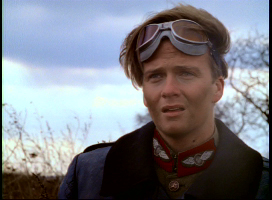 Just a couple of months ago DVD collectors and fans of Indiana Jones had something to cheer about. Paramount and Lucas got together to release the first volume of The Adventures of Young Indiana Jones and it was better than we could have hoped for. Sure the original episodes were presented in their cut and pasted versions and yes the price of the package was kind of high, but we couldn't deny the sheer entertainment value and bevy of supplemental features.
Just a couple of months ago DVD collectors and fans of Indiana Jones had something to cheer about. Paramount and Lucas got together to release the first volume of The Adventures of Young Indiana Jones and it was better than we could have hoped for. Sure the original episodes were presented in their cut and pasted versions and yes the price of the package was kind of high, but we couldn't deny the sheer entertainment value and bevy of supplemental features.
Thankfully we didn't have to wait years for the second installment to hit the market and just last month we had it in our hands. Once again the production values for the DVD were phenomenal, the bonus content was exemplary, and the episodes/films proved every bit as entertaining now as they did when they were created. The cost of admission for this release is still a tad on the high side but if you ask me it's well worth it. Few shows receive as much attention to their packaging and when you couple that with the quality of the series you come out with a pretty good bargain.
In case you missed The Adventures of Young Indiana Jones and are only familiar with Harrison Ford's Indiana Jones then you're in for something of a treat. Did you ever wonder exactly how Indy became the brave adventurer he was? In The Last Crusade we were treated to a younger Indiana Jones and heard many amusing tales about the past from his father but there wasn't a wealth of information regarding his previous exploits. Young Indiana Jones sought to change all of that and give us a look at his earlier years. But rather than just focus on Indiana's growing pains each episode placed our protagonist in the midst of history. Watch a single episode and you'll see prominent characters and events of the time period. Sure it got to be a little ridiculous at times but the fact remained that the show educated kids while it entertained them; something that doesn't happen that often with television.
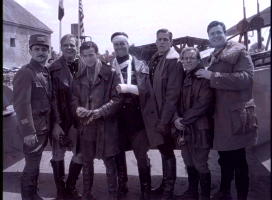 When the series aired the content jumped between a young Henry Jones traveling with his parents and a seventeen year old Jones fighting in Europe during World War I. The films were pieced together in an attempt for form a more cohesive experience as many times one storyline fed off of another. We saw some examples of that in the first volume of The Adventures of Young Indiana Jones though there were a couple of transitions between plots that didn't happen so smoothly. The content on the DVD set also seemed to adhere more to chronology rather than production date as the first part of the box included adventures of the younger Indy (Cory Carrier) and the latter featured the teenage Jones (Sean Patrick Flanery).
When the series aired the content jumped between a young Henry Jones traveling with his parents and a seventeen year old Jones fighting in Europe during World War I. The films were pieced together in an attempt for form a more cohesive experience as many times one storyline fed off of another. We saw some examples of that in the first volume of The Adventures of Young Indiana Jones though there were a couple of transitions between plots that didn't happen so smoothly. The content on the DVD set also seemed to adhere more to chronology rather than production date as the first part of the box included adventures of the younger Indy (Cory Carrier) and the latter featured the teenage Jones (Sean Patrick Flanery).
Keeping with the formula, the second installment of The Adventures of Young Indiana Jones solely features Flanery as everyone's favorite archaeologist. Jones, along with his pal Remy (Ronny Coutteure), tour Europe during the eight films here. Along the way the tradition of Indiana meeting historical figures remained. Throughout these episodes you'll see Albert Schweitzer, Mata Hari, The Red Baron, Charles de Gaulle, and Siegfried Sassoon just to name a few. Sure it's unbelievable and yes it can be a little hokey at times, but the fact remains that this is an entertaining program. As you watch you really won't care how Indy conveniently finds himself in the middle of history. It's simply fun and somewhat educational, though I do have to admit that the documentaries take the cake in that regard.
The second volume of The Adventures of Young Indiana Jones kicks things off with the charmingly named "Trenches of Hell". Indiana has joined the Belgian army with his pal Remy and has taken on an alias, Henry Defense. His squad is dogged upon by their French allies but in the battlefield they all die the same way. Indy is surrounded by death and he's taking part in an assault that seems almost pointless. His friends are dying, nerve gas fills the air, and all hope seems loss. To make matters worse he's captured and brought to a German internment camp.
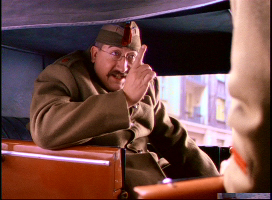 Prior to arriving Indy and a fellow Belgian took the identities and clothing of French officers. Fortunately for the pair they were treated as such and landed in a place where a breakout was just about to occur. Things head south quickly and Jones finds himself landing in a maximum security prison where Charles de Gaulle (Herve Pauchon) is being kept. Once again Indiana gets caught up in an escape plan but the manner with which it occurs is certainly unconventional. Overall I felt this episode was a great way to start this collection off right as it not only captured the fun atmosphere of the show but also the harsh realities of the war Indy found himself in.
Prior to arriving Indy and a fellow Belgian took the identities and clothing of French officers. Fortunately for the pair they were treated as such and landed in a place where a breakout was just about to occur. Things head south quickly and Jones finds himself landing in a maximum security prison where Charles de Gaulle (Herve Pauchon) is being kept. Once again Indiana gets caught up in an escape plan but the manner with which it occurs is certainly unconventional. Overall I felt this episode was a great way to start this collection off right as it not only captured the fun atmosphere of the show but also the harsh realities of the war Indy found himself in.
"Demons of Deception" is the second episode you'll find in this box set. I found that this episode wasn't quite as good as the previous one but it still featured many layers of depth. More trench warfare shows the plight of war as commanding officers order wave after wave of soldiers to their death for hardly an inch of ground. Indiana is caught in the middle of it all but sees some respite when he's brought back to civilization and visits an old friend of his father (played by Ian McDiarmid). While there he bumps into Mata Hari and has a little affair with the infamous dancing spy. Not bad for a 17 year old!
The third film in this set was "Phantom Train of Doom" and I think it's fair to say that this was one of my favorite episodes. It begins innocently enough with Indiana and Remy being redeployed to Africa but they accidentally take a few wrong trains and wind up in the middle of nowhere. Even so they encounter allied forces and Indy is enlisted to aid some elderly soldiers who have been charged with destroying a massive train-mounted cannon. While traveling with the geezers Indiana learns a thing or two about improvising depending upon the situation and seems to gain some maturity in the process.
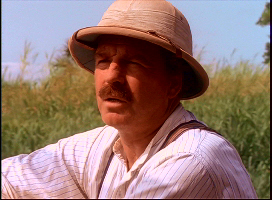 While still in Africa, Jones is promoted to the rank of Captain. But his brashness doesn't sit well with some superior officers and he's sent with a party to cross the Congo in order to get a shipment of guns. Along the way just about everybody falls ill and most of the platoon dies out thanks to malaria and all other manner of sickness and disease. Fortunately for Indy and those that are left alive they wind up in the care of Albert Schweitzer who nurses them back to health and teaches Indy a thing or two about humanity. It's his experiences with Schweitzer that prompts him to seek different assignments that don't put him on the front lines.
While still in Africa, Jones is promoted to the rank of Captain. But his brashness doesn't sit well with some superior officers and he's sent with a party to cross the Congo in order to get a shipment of guns. Along the way just about everybody falls ill and most of the platoon dies out thanks to malaria and all other manner of sickness and disease. Fortunately for Indy and those that are left alive they wind up in the care of Albert Schweitzer who nurses them back to health and teaches Indy a thing or two about humanity. It's his experiences with Schweitzer that prompts him to seek different assignments that don't put him on the front lines.
Indy and Remy take advantage of an opportunity and go their separate ways for "Attack of the Hawkmen". Remy gets sent home to Belgium which makes him happy because he'll be a spy at a place he knows and still be able to see his wife and children. Indiana, however, gets charged with a more dangerous assignment that sends him into the air for some aerial reconnaissance. Once he arrives at the French airfield he bumps into someone he knew from back in America and eventually finds himself in the thick of some serious combat in the sky. The to make matters worse the infamous Red Baron comes into play as Indy goes undercover to delivery a message to Anthony Fokker (Craig Kelly).
The intelligence and spy games continues as Indiana travels with some comrades deep into the heart of the beast to meet with Emperor Karl of Austria (Patrick Ryecart). He has gone to see the Emperor in an effort to bring an expedient end to the war but things don't go quite as planned. Then again, when Jones is involved does anything ever go the way it's supposed to? This was another fine episode, though I didn't feel it was one of the stronger ones found in this volume. I do have to say the highlight here was a guest appearance by Christopher Lee as Graf Czerin.
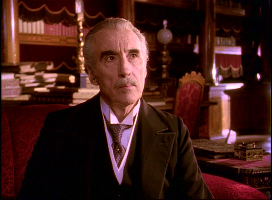 More spying games for Jones lie ahead as he goes to Barcelona and pretends to be a dancer in the Ballets Russes in Spain. That in itself was kind of silly but within the confines of the series I suppose it worked. This particular episode sees Danny Webb reprising his role as Pablo Picasso. It's kind of amusing when they see each other again because Pablo doesn't quite remember Indy. Instead he thinks our star is Norman Rockwell who Indiana traveled with when they bumped into Picasso back in 1908 when his family went to Paris. Overall this episode was silly, yet fun and it got even more entertaining when the second part took Indy to Prague.
More spying games for Jones lie ahead as he goes to Barcelona and pretends to be a dancer in the Ballets Russes in Spain. That in itself was kind of silly but within the confines of the series I suppose it worked. This particular episode sees Danny Webb reprising his role as Pablo Picasso. It's kind of amusing when they see each other again because Pablo doesn't quite remember Indy. Instead he thinks our star is Norman Rockwell who Indiana traveled with when they bumped into Picasso back in 1908 when his family went to Paris. Overall this episode was silly, yet fun and it got even more entertaining when the second part took Indy to Prague.
The final film on the second installment of Young Indiana Jones was easily one of the best of what's here. "Daredevils of the Desert" thrust Indy behind the enemy lines once again but this time the storyline featured Catherine Zeta Jones and Daniel Craig as co-stars for his exploits. This particular plot had a very Lawrence of Arabia feel to it but the Indiana Jones' sense of style added its own flair.
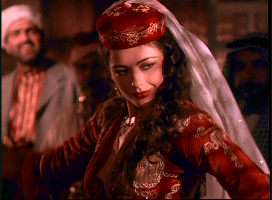 All around each film here is highly entertaining and should be required viewing for fans of the Indiana Jones franchise. The writing was fantastic, the style in many ways matched the movies, and the way bits of history were strewn into the various plots was brilliant. There are a couple of holes in consistency such as Remy's insistence on finding French prostitutes during one episode but bemoaning never seeing his beloved wife and children in another. Overall things stay fairly consistent and these episodes have many throwbacks to adventures of the younger Indy such as appearances by familiar faces and our hero's penchant for writing letters to his buddy T.E. Lawrence.
All around each film here is highly entertaining and should be required viewing for fans of the Indiana Jones franchise. The writing was fantastic, the style in many ways matched the movies, and the way bits of history were strewn into the various plots was brilliant. There are a couple of holes in consistency such as Remy's insistence on finding French prostitutes during one episode but bemoaning never seeing his beloved wife and children in another. Overall things stay fairly consistent and these episodes have many throwbacks to adventures of the younger Indy such as appearances by familiar faces and our hero's penchant for writing letters to his buddy T.E. Lawrence.
If you picked up the first installment and had a good time then you're going to love the content here. The stories were much better all around and the older Indy allowed for stronger morality to be brought into play. War is hell and through Indiana's eyes we get to see different points from history that generally go overlooked. The eight films included here are fantastic and the addition of interesting educational documentaries tips the scales. This is another must buy for history buffs and Indiana Jones fans!
The second volume of The Adventures of Young Indiana Jones comes with packaging similar to the first. The two releases look great next to each other and they compliment the trilogy's box set quite nicely. Weathered artwork blankets the package though the outer box is flimsier and smaller than the one presented with the movies and there is no raised lettering to make the title stand out. Inside the set is a fold-out booklet that contains nine DVDs opposed to twelve from the first volume. The eight films and documentaries cover the content from discs 1 through 8 with the 9th being reserved for interactive features.
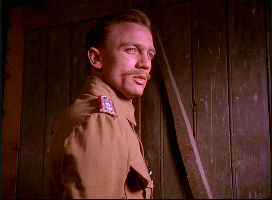 Like the first set, this collection of episodes from The Adventures of Young Indiana Jones comes to DVD with a full frame aspect ratio. As you may or may not be aware Young Indiana Jones was shot using 16mm film rather than the standard 35mm in an effort to save on production costs. This allowed the creative team the chance to blow the budget on locations and sets which really take the cake in these episodes with spots from around the world and a ton of explosions.
Like the first set, this collection of episodes from The Adventures of Young Indiana Jones comes to DVD with a full frame aspect ratio. As you may or may not be aware Young Indiana Jones was shot using 16mm film rather than the standard 35mm in an effort to save on production costs. This allowed the creative team the chance to blow the budget on locations and sets which really take the cake in these episodes with spots from around the world and a ton of explosions.
In similar fashion to the first volume, the second includes some great video quality that truly stands the test of time. The 16mm master has been spruced up wonderfully for this release and things look very good. Sure the transfer isn't perfect as some grain, shimmer, and edge enhancement popped up from time to time but I must say that the work done here has revitalized the show. Considering the age of the material the video should have featured more flaws than are presented here but thanks to Lucas' tenacity for quality transfers the reputation flourishes in this regard.
While the video presentation showcased a mastery of restoration to the original picture I have to say that the audio falls short on expectations. The Adventures of Young Indiana Jones hits DVD with a somewhat lackluster 2.0 English Dolby Digital soundtrack. Part of me was hoping for a 5.1 remix or some type of glorious enhancement given Lucas' track record so the simplistic offering here disappointed.
For what it is the audio is admittedly astute. Dialogue remains crisp and clear with a fine presence on the front channel. There is very little separation with this set up and sound effects comes across as flat on occasion. I suppose it was folly to expect something grandiose from a television show that aired during the early 90's but I can't help feel that the soundtrack could have had more vitality to it. The only available option as far as setting up your DVD experience is the ability to turn English subtitles on or off.
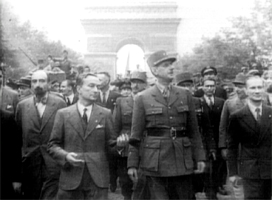 Much like the first volume of The Adventures of Young Indiana Jones, the second comes packed with bonus content. Well, I don't know that you should really categorize these educational documentaries as extra features because they could have justified a release all their own. I had just as much fun watching the documentaries as I did the actual episodes from the show itself. That's quite the statement for a DVD release for a television series.
Much like the first volume of The Adventures of Young Indiana Jones, the second comes packed with bonus content. Well, I don't know that you should really categorize these educational documentaries as extra features because they could have justified a release all their own. I had just as much fun watching the documentaries as I did the actual episodes from the show itself. That's quite the statement for a DVD release for a television series.
The first disc of this set features four documentaries all having to do with the subject matter handled in "Trenches of War". First up is a feature about the Somme Valley in France which was altered completely by World War I. "The Somme" (26:49) documentary talks at length about the harsh experiences that so many people had. Tens of thousands died in such a short amount of time, armies fought over the bodies of their dead, and throughout it all this remained one of the bloodiest encounters of the First World War. Trench warfare has always been defined as hell on earth but the Somme was apparently the literal embodiment of that.
"Siegfried Sassoon: A War Poets Journey" (30:09) focuses on the life of the soldier poet Siegfried Sassoon and what inspired him to enlist. As the documentary stated he came from a privileged life and knew nothing about the plight of man until he moved to London and was caught up in the fervor surrounding the war. He was an aspiring poet then and took his craft to the battlefield where he joined others as War Poets in an attempt to put into words the horrors they dealt with on a daily basis. His works made an impact on society and while he spoke out against war it's safe to say that his poetry defined much of the way we look at World War I.
Along the lines of poetry "Robert Graves and the White Goddess" (30:18) is the next documentary on the first disc. Similar to Sassoon, Graves penned some haunting poems about the realities of war and his perception of events changed the way the world looked at things. This documentary takes a look at his inspiration and questions his sanity in the process. Graves has been described as mad but it's that which gives him the brilliance that took him to write over 140 books.
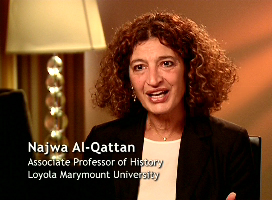 Charles de Gaulle's documentary is the final feature on this disc. In "I Am France: The Myth of Charles de Gaulle" (30:09) we learn a lot about the belief that he would be the savior of France. The documentary goes through events of his early life and spends a decent amount of time discussing his relevance to the war and recovery of France afterwards. The most interesting thing about de Gaulle was probably his feeling of destiny. He felt to his core that he was fated to save France and he followed that belief long enough to make it so. Granted he bent truths to lean opinion in his favor but you can't deny that he carved his place in history just like he wanted.
Charles de Gaulle's documentary is the final feature on this disc. In "I Am France: The Myth of Charles de Gaulle" (30:09) we learn a lot about the belief that he would be the savior of France. The documentary goes through events of his early life and spends a decent amount of time discussing his relevance to the war and recovery of France afterwards. The most interesting thing about de Gaulle was probably his feeling of destiny. He felt to his core that he was fated to save France and he followed that belief long enough to make it so. Granted he bent truths to lean opinion in his favor but you can't deny that he carved his place in history just like he wanted.
The second disc offers four more documentaries to peruse, each of them as educational and interesting as the rest of the package. The first documentary up for viewing is "Into the Furnace: The Battle of Verdun" (28:45) and it focuses on one of the largest and costliest battles fought during the World War. When the German forces arrived at Verdun they did so by surprise and with the intent on fighting a war of attrition both sides took casualties mounting into the millions. This battle was waged for a long time and came to be known as a meat grinder of sorts.
"Marshal Petain's Fall From Grace" (30:41) is up next and was one of the most interesting personnel documentaries available on this set. Petain is famed for becoming a hero in the early parts of the Great War and his strategies not only saved French lives but shaped history. Due to his decisions the common soldier loved him but his superiors did not. However, when things came to their worst and mutiny seemed inevitable Petain was the only one who could smooth things over and restore order. Like de Gaulle he was considered a savior of France by the people and adored all around until his decision making in Word War II. He would be considered a traitor and destructor of the French morale and thusly exiled to an island where he died in 1951 at the age of 95.
The third documentary on this disc was "Flirting with Disaster: The Fantasy of Mata Hari" (29:53). In this feature commentators along with photos and the like are used to describe the tumultuous lifestyle of one of the most famed exotic dancers of all time. Mata Hari crafted an air of mystery around her and in every opportunity she used the press to make herself appear to be an enigma. This mysteriousness coupled with her sensual dancing made her a very public figure in high society. Along the way she had contact with Germans and began to spy though many of the people discussing her life in this feature denounce that. They believe she took money from the Germans like she did everyone else and never actually betrayed France.
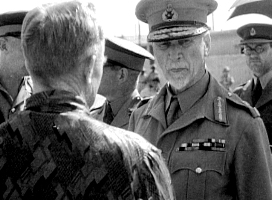 Keeping up with the spy theme is "Reading the Enemy's Mind: Espionage in World War I" (24:21). Mostly due to my personal interest in the material I found this documentary to be particularly fascinating. It covered at length Germany's tactics on US soil prior to our involvement in the war. From bringing a submarine right to our docks to destroying an ammunitions warehouse known as Black Tom that was about to supply the Russians with artillery it's safe to say that some interesting stuff went down. There's even some footage of the wreckage from Black Tom. The documentary also goes on to talk about other forms of espionage and exactly how the German communication codes were broken.
Keeping up with the spy theme is "Reading the Enemy's Mind: Espionage in World War I" (24:21). Mostly due to my personal interest in the material I found this documentary to be particularly fascinating. It covered at length Germany's tactics on US soil prior to our involvement in the war. From bringing a submarine right to our docks to destroying an ammunitions warehouse known as Black Tom that was about to supply the Russians with artillery it's safe to say that some interesting stuff went down. There's even some footage of the wreckage from Black Tom. The documentary also goes on to talk about other forms of espionage and exactly how the German communication codes were broken.
The third disc which features "Phantom Train of Doom" includes three documentaries all pertaining to personalities that you'll find in the episode. First up is Paul von Lettow-Vorbeck otherwise known as the Phantom. In the Young Indiana film his character was very interesting and alluded to him being a man of great stature and charisma. "Chasing the Phantom: Paul von Lettow-Vorbeck" (24:54) explores that and gives us some insight into the man that would be the stuff heroes were made from (if he wasn't fighting for the German's that is). By the end of the First World War he would be Germany's only undefeated General and celebrated as such upon his return. He stood on the opposing side of the Nazi party and fell into poverty during World War II. The documentary also goes on to discuss his relationship of sorts with Jan Smuts which personified gentlemanly conduct even during times of war.
The next person up for educational purposes is Fredrick Selous in "Dreaming of Africa: The Life of Frederick Selous (25:06). This documentary goes into detail about the famous hunter of the African wild and includes excerpts from his book and personal journal. There's much bravado surrounding Selous and it's safe to say that his "dream" made him a man's man. And finally, the third disc also includes "At Home and Abroad: The Two Faces of Jan Smuts" (32:17). While Smuts may have had relations von Lettow he had a way of behaving differently when he was in South Africa and when he was in the world stage. The world recognizes him as someone who signed peace treaties for both World Wars and UN Charter but at his home things certainly seemed different.
The African documentaries continue with the "Oganga, The Giver and Taker of Life" disc. The first feature here is "Albert Schweitzer: Reverence for Life" (29:47) and like the other discussions of persons of interest here it focuses largely on his earlier life and what drove him to make the decisions he made. From his works in Africa healing the sick to his quest for a defining philosophy for his feelings about life in general this documentary includes a lot of information. Many experts chime in on the subject of the Medicine Man but the most intriguing and personal came from Albert's daughter Rhena who makes an appearance with some comments.
"Congo: A Curse of Riches" (32:39) chronicles the plight of the Congolese over the past 100 years or so. It all started back when King Leopold from Belgium heard about the mysterious Congo and decided to steal the land from its rightful people. Since then millions have been tortured and killed over the resources like rubber and copper. From one corrupt oppressor to the next and even an assassination that reportedly involved Americans in between it's safe to say that the Congolese live a hard and tragic life. This documentary really sheds light on some of what has been going on in the Congo since it made its way onto the world stage.
A year after the war started Henry Ford led a peace envoy to Europe in an effort to convince the warring nations that there was no sense in fighting. Peace was supposedly better for business, plus war was messy. "Waging Peace: The Rise of Pacifism" (26:02) covers a wide variety of wars and the many decades since the creation of the Fellowship of Reconciliation and the peace movement. From Ghandi to the anti-Vietnam War rallies there is some interesting stuff here though I felt some of the material was slightly lighter than the other documentaries included here.
Disc five takes to the skies with "War in the Third Dimension: Aerial Warfare in World War I" (26:43). This documentary discussed how aviation impacted the war and changed the face of battle. From zeppelins to crude aircraft at the beginning this feature goes through the rise of technology and its implementation. During this time "Blood Red: The Life and Death of Manfred von Richthofen" (27:34) features the life of the Red Baron. During the war he carved a name and reputation for himself by being the most fearsome foe in the sky. He raised the bar for combat which is kind of impressive considering at the start of the war he was merely a cavalry rider and not a pilot.
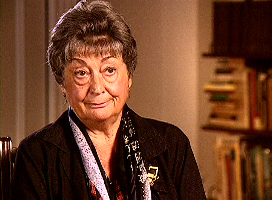 "Flying High for France: The Lafayette Escadrille" (26:13) focuses on the band of American would-be pilots who flew for the French during the war. This eccentric bunch had never flown before but entered the fight seeking glory. The documentary not only depicts their conquests but their tenacity for living life as if there were no tomorrow. From keeping pet lions named Whisky and Soda to drinking whisky and soda every night and chasing girls, the Lafayette Escadrille was a very interesting bunch. Inventor and aviation expert Anthony Fokker gets some attention here with "Anthony Fokker: The Flying Dutchman" (27:31). It's safe to say that with the advent of flying technology Fokker was a visionary and this documentary takes a look at his interest in the subject matter and various influences.
"Flying High for France: The Lafayette Escadrille" (26:13) focuses on the band of American would-be pilots who flew for the French during the war. This eccentric bunch had never flown before but entered the fight seeking glory. The documentary not only depicts their conquests but their tenacity for living life as if there were no tomorrow. From keeping pet lions named Whisky and Soda to drinking whisky and soda every night and chasing girls, the Lafayette Escadrille was a very interesting bunch. Inventor and aviation expert Anthony Fokker gets some attention here with "Anthony Fokker: The Flying Dutchman" (27:31). It's safe to say that with the advent of flying technology Fokker was a visionary and this documentary takes a look at his interest in the subject matter and various influences.
Moving onto the sixth disc are three more documentaries. First up is "Karl: The Last Habsburg Emperor" (29:49) which features several of his descendants talking about the man. The documentary discusses many aspects of his life and what lead to his ascendance to sainthood in 2004. "The Russian Revolt: All Power to the Soviets" (33:36) talked at length about the Russian peasant's fight for freedom. Downtrodden and destitute most Russians were living in squalor and everything came to a boiling point. From 1905's Bloody Sunday to the march of women demanding bread there were several components that slowly came together to set up revolution against the Czar.
The final documentary on this disc was "V.I. Lenin: History Will Not Forgive Us" (33:54). It's hard to deny that Lenin left an influential mark on Russia and shaped the face of things to come. His harsh methods, which sparked revolution, are featured here and much of his earlier life comes into play. He and his family were ostracized by his neighbors thanks to his brother's attempt on the Czar's life and let's just say that didn't sit well. This documentary provides insight into what made Lenin the prominent figure that he was on the world stage.
Onto the "Espionage Escapades" disc, "Impresario: Sergei Diaghilev and the Ballets Russes" (28:13) took a look at Diaghilev the man and how his ballet changed the way the world looked at it. From recognizing young talented dancers to picking out choreographers, Diaghilev was a visionary in the field of ballet. Given the theme "Ballet: The Art of Dance" (32:16) is similar to some of the topics available on the first Jones volume. Rather than focusing on a single place in time this documentary takes a look at ballet throughout the years with a strong focus on the modern era.
"Franz Kafka's Dark Truth" (31:21) explores Kafka's life and goes into what drove him to be such a bleak personality and powerful writer. It all started at a young age when his father locked him out onto the balcony for wanting a glass of water in the middle of the night. From there it snowballed into depression and possibly other forms of mental illness that Kafka grappled with on a daily basis. His soulless job at an insurance company didn't help matters but it was his writing that kept him going. Visionary and dark are the best ways to describe his work and it's safe to say that his stories offer a glimpse into his heart and soul. I didn't feel that his character was used appropriately in the "Espionage Escapades" episode but this documentary did his personality some justice.
On the eighth disc there are only two documentaries to peruse. "Lines in the Sand: The Middle East and the Great War" (34:29) looks at the way World War I impacted the Middle East. From ethnic cleansing, to regime changes, to altered boundaries the shape of the Middle East shifted during the war. T. E. Lawrence comes into play here as well but the focus is put entirely on him in "Colonel Lawrence's War: T.E. Lawrence and Arabia" (36:05). While this documentary was interesting if you watched the first volume of The Adventures of Young Indiana Jones then you'll recognize it from there. This particular inclusion is a double dip and quite honestly it didn't need to be here.
The final disc in this box set includes some interactive material such as a timeline of the war and a DVD game which can be accessed through your PC. The most notable feature from this disc is "War and Revolution with H.W. Brands, Professor of History" (1:02:31). With a boatload of passion and knowledge, Brands discusses many elements that lead to the Great War and some of what transpired during it. While the individual documentaries on this set offer a glimpse at specific subject matters Brands offers interesting commentary on the war as a whole.
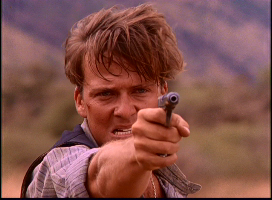 Well, there you have it. Another The Adventures of Young Indiana Jones comes along and impresses in just about every way. The ambitious Lucas project turned out to be something special and even in this edited form the Jones adventures are highly entertaining. The quality of the show coupled with some great video restoration really brings it home for a new generation. Like the first installment, the audio here is a tad underwhelming but it's serviceable to be sure.
Well, there you have it. Another The Adventures of Young Indiana Jones comes along and impresses in just about every way. The ambitious Lucas project turned out to be something special and even in this edited form the Jones adventures are highly entertaining. The quality of the show coupled with some great video restoration really brings it home for a new generation. Like the first installment, the audio here is a tad underwhelming but it's serviceable to be sure.
The wealth of educational documentaries is also staggering. Quite honestly these inclusions shouldn't technically be considered extra features. Instead they should be looked upon as a separate release altogether. What we have in the end is a dual package. On one hand we have The Adventures of Young Indiana Jones which was a fantastic show while on the other we have highly informative and interesting documentaries. With over twelve hours of material this set is hefty and worth its weight in gold for Indiana Jones fans or history buffs. The content this time around was better and more extensive than the first release and because of that this collection gets the coveted DVD Talk Collector's Series rating.
Check out more of my reviews here. Head on over to my anime blog as well for random musings and reviews of anime, manga, and stuff from Japan!
|
| Popular Reviews |
| Sponsored Links |
|
|
| Sponsored Links |
|
|
| Release List | Reviews | Shop | Newsletter | Forum | DVD Giveaways | Blu-Ray | Advertise |
|
Copyright 2024 DVDTalk.com All Rights Reserved. Legal Info, Privacy Policy, Terms of Use,
Manage Preferences,
Your Privacy Choices | |||||||













